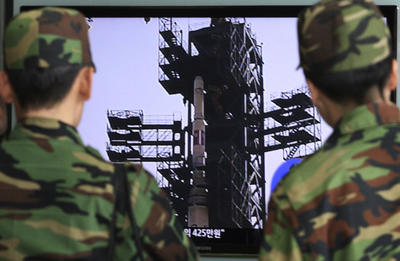Furthermore, North Korea would allow outside monitoring of both food aid distribution and its nuclear freeze. The latter specifically meant letting back in the International Atomic Energy Agency (IAEA), whose inspectors were expelled in 2009.
This all seemed remarkably good news. Unusually, the DPRK appeared to be offering much in exchange for, frankly, not a lot: less than a month’s supply of grain.
There were of course caveats. The US and DPRK texts differed in emphasis. The North Korean version only got to what it had agreed to do — three moratoria and the return of the IAEA — in the final paragraph, and added a conditionality: ‘…while productive dialogues continue’. Also, all of this only covers the North’s known Yongbyon nuclear site. As with Iran, the suspicion is that HEU activity may also be going on elsewhere, at facilities unknown and undeclared.
Still, this was the first good news on the DPRK nuclear issue in a long time. The Leap Day Agreement (LDA), if duly implemented, might lead to resumption of the Six Party Talks which last convened in 2008. This raised hopes that Kim Jong-un might be a man of peace after all, even though since his elevation he has been active visiting the Korean People’s Army (KPA).
But the new mood of cautious optimism was rudely shattered barely a fortnight later. On March 16 the (North) Korean Committee for Space Technology (KCST) announced that it will launch a polar-orbiting earth observation satellite, Kwangmyongsong-3, sometime between April 12 and 16 to mark Kim Il-sung’s centenary. Describing it as ‘a working satellite … manufactured … with indigenous technology’, the official Korean Central News Agency (KCNA) added that this followed the previous experience of ‘launching two experimental satellites’. This refers to earlier rockets sent up in 1998 and 2009.
The concern is that for all practical purposes what North Korea calls its Unha carrier rocket is more or less identical to its Taepodong long-range ballistic missile. Pyongyang’s claims that a space rocket is not a missile are disingenuous. Even if Kim Jong-un is a greenhorn on such matters, those advising him know both the technical and political ramifications of all this perfectly well. 1998 apart, North Korea’s more recent second ‘satellite launch’ in April 2009 — the satellite failed, but the rocket flew an impressive 3,800 km — was censured by the UNSC in a presidential statement as violating an earlier UNSC resolution which forbade the DPRK to engage in ballistic missile activities.
So the North Koreans know what they are doing. The question is: Why? One can posit at least three theories.
The first theory is divided counsels. The LDA may have been offered in good faith by the Ministry of Foreign Affairs, only for the KPA to promptly torpedo it.
A second variant is a lack of policy coordination. Competing bureaucracies are a feature of all modern societies. The DPRK is no exception. According to US intelligence analyst Patrick McEachern, the Party, KPA and Cabinet each have their own interests, which may not coincide. Moreover, North Korea is notoriously top-down and silo-like. The wise person sticks to their own patch and obeys orders; lateral contact between institutions is off-limits.
Such a system clearly risks having problems of coordination. That was where Kim Jong-il came in. A hands-on micro-manager, he and only he sat spider-like at the centre and apex of this web. Quite literally, only the Dear Leader knew all that was going on. So his death leaves a void which Kim Jong-un cannot yet be in a position to fill. In such a time of transition, the left hand might not quite have grasped what the right is up to.
A third theory contradicts both the foregoing: North Korea is trying to have its cake while eating it, gambling that in the end the US will not allow the space launch / missile test to become a deal-breaker, so keen is it to have the IAEA go back in — especially to get a first proper look at the HEU facility at Yongbyon. In this they may even be right. Or it may prove a misjudgement as President Obama — facing a tough re-election battle against Republicans, many of whom regard North Korea as akin to the antichrist — cannot afford to look soft.
The LDA will surely go on ice for now: to show US disapproval, and while the world waits to see whether the Kim Il-sung centenary celebrations and the Worker’s Party of Korea conference, scheduled for mid April, will bring any further clarification — or bombshells.
Aidan Foster-Carter is Honorary Senior Research Fellow in sociology and modern Korea at Leeds University and a freelance consultant, writer and broadcaster on Korean affairs.
A longer version of this article first appeared at, and is used with the kind permission of, NewNations.com.


I think that people are forgetting that North Koreans are normal, innocent people who live under a terrible regime. They deserve a voice.